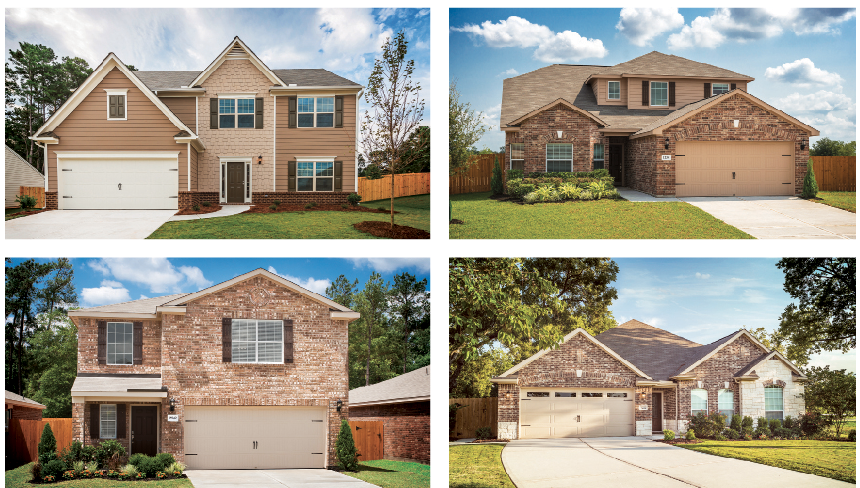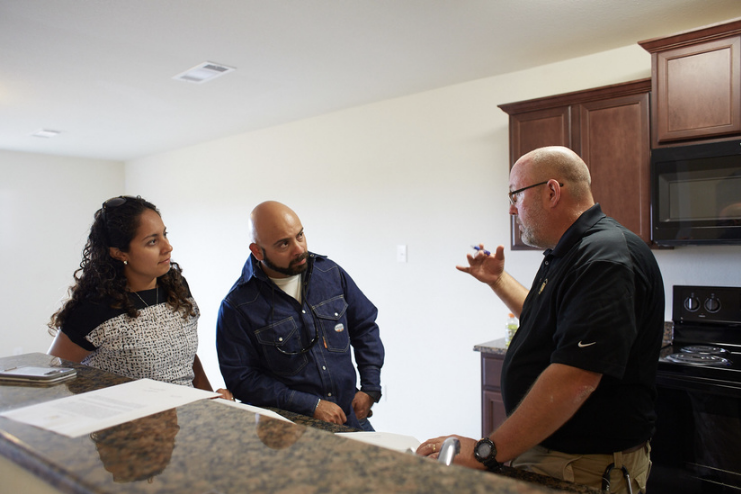When 305 lots in Bella Vista appeared on LGI’s radar, Denver locals told the Houston builder’s land acquisition team that the neighborhood wasn’t the place to build single-family homes. Lochbuie, Colo., was too rural, too far away from anything, and previous builders that tried to launch a community there failed. The dirt was merely another builder’s D or F land, and no one who wanted to work or live near Denver would move to Lochbuie, they said.
As Jack Lipar, EVP of acquisition, looked around the collection of finished lots amid the backdrop of pine trees and the Rocky Mountain foothills, his first thought was not the industry adage about land acquisition that warned, “Don’t buy another builder’s mistake.” Instead, he thought to himself, “We can sell this place.”
Eric Lipar, chairman and CEO, and Mike Snider, president and COO, later visited Colorado subcontractors and real estate agents to recruit trade partners and gather market intelligence. They showed their hosts photos and drawings of the 1,100-to-2,500-square-foot three-, four-, and five-bedroom homes they built on slabs in Houston, San Antonio, and Dallas. The locals rejected the designs out of hand. Those products may work in Texas, they said, but you’ve got to have a basement to sell a house in the metro Denver market.

CFO Charles Merdian elaborates on LGI core values: exceptional customer service, loyalty, integrity, ethical behavior, efficient use of time and resources, and profitability. Management training stresses six characteristics of the “right” people: fitting with company core values; not needing to be tightly managed; knowing they don’t have a job, they have responsibilities; fulfilling commitments; passion for the company; and window/mirror maturity (the ability to reflect on self and others)
LGI began selling the slab community in March 2015 with prices starting at $229,900. The median sold price for a detached single-family home in metro Denver then was $325,000. The company closed 45 homes within six months and 182 units are closed or pending contracts as of November.
Today, LGI is building in seven locations around Denver and Colorado Springs in addition to expanding last year into Jacksonville, Fla., and Seattle, with Nashville, Tenn., Portland, Ore., Raleigh-Durham, N.C., Indianapolis, Las Vegas, and Minneapolis next on the short list. Overall, the company has closed sales in 61 active communities in 16 markets in 10 states across the country, primarily selling to renters who become first-time homebuyers.
“The product doesn’t sell the house,” says Jack, a former auto-parts manufacturing executive who was recruited by Eric, his second cousin. “By the time a person calls our sales office, they’re not looking for a basement. They’re looking for homeownership, and we look for the most affordable way to build a house that we can get a customer into. That’s how we ended up building slabs instead of basements.”
LGI has flipped industry convention, which typically organizes company functions around the core activity of building houses. Instead, LGI stakes its flag on acres surrounded by at least 40,000 renters within a 30-mile radius. It operates its new home information centers like retail stores that stay open 12 hours a day, 359 days a year, with two to five new-home consultants per office. At a time when big-data proponents preach that home builders need to do a deep dive and mine demographics so they can reach prospects, LGI just needs to know that its customers are renters who want to buy a house in the company’s price range. To meet their needs, LGI activates land acquisition, construction, marketing, and sales systems that fulfill customers’ dreams of owning a home where they can host Thanksgiving dinners and watch their kids play in the backyard.
The little company that started in Conroe, Texas, in 2003 flourished during the recession, raised $102.6 million from its November 2013 IPO, and has since moved its headquarters to the tony environs of The Woodlands. Professional Builder’s 2016 Builder of the Year saw closings jump more than 40 percent annually between 2010 and 2015, when it closed 3,404 houses—and expects to finish 2016 with an increase between a very respectable 20 percent to 25 percent. LGI also has been one of the more profitable publicly traded home builders, posting gross margins ranging between 26.3 percent and 28.5 percent since it issued common stock shares.
Company Culture
In the training room of Houston headquarters and information centers nationwide hang signboards listing the 13 beliefs and behaviors that define LGI company culture:
– Systems-based company (LGI way)
– We, us, together vs. I, me, my, them
– CANI (Constant and Never-Ending Improvement)
– Hire the best
– People-focused
– If an employee fails, it is the manager’s fault
– Corporate exists to support field operations
– Sales and closings
– Best sales system in the world
– People sell homes, not the home itself
– The sales system is designed for the customer to make a decision on the first visit
– Cleanest jobsites in the world
– Construction manager will be correct 100 percent of the time when he/she builds homes according to plan
LGI's Marketing and Sales Systems
On an October morning, 25 new sales employees hired during the past 90 days from Raleigh, Portland, and Nashville gathered in LGI’s training room for their first week of work. They were flown to Houston, put up in a nearby hotel, and will return during their third week on the job for an additional round of learning the ropes. There will be more training during their first 100 days, and weekly sessions in their home offices thereafter. Most have previous experience selling: cell phones, insurance, autos, real estate, and other products and services that demand working retail hours and weekends.
“I would say we have untraining to do with anyone we hire,” Eric Lipar says, “just because we have our particular beliefs about what we want them talking about and how we want them to deal with the customer.”
Eric leads the first morning of training, and Snider handles the remainder of the week. The senior managers begin by pointing out two shelves near the corner of the room stacked with thick real estate and insurance binders, a white Pulte hard hat, a KB Home coffee mug, a jar labeled “Bad Habits,” and other knickknacks. They emphasize that the trainees need to put everything they know or think they know about selling on the shelf and commit to LGI’s system for selling.

On day one of sales training, CEO Eric Lipar (standing) and sales manager Rick Rodrigues (seated, at right) watch a presentation.
That system is documented in the “Professional Sales Action Manual,” one of 10 company manuals written for every position in every department of the company, whether it’s land acquisition, development, sales management, or construction. Each manual spells out the LGI way to do business and the processes that are replicated in every market. Mounted on the training room walls are signboards that also appear in every information center nationwide. The trainees will use these boards as talking points with customers to explain the benefits of doing business with LGI. For example, the “Value/History of Success” board notes that LGI is one of the fastest growing home builders in the nation, takes pride in meeting the unique needs of first-time buyers, and has moved in more than 15,000 families since it was founded.
“People don’t want to feel left alone. They want to know that they’re doing business with a company that is solid and has been around,” Eric Lipar says. “I think it’s important for our customers to know the type of company we are and our values, if we are going to ask them to do business with us.”

New-home consultants Brad Huxford (left) and Albert Maldonado (center) at The Trails at Seabourne Parke information center near Houston. Sales manager David Badillo updates the whiteboard that tracks sales appointments and outcomes. A board like this hangs in every LGI information center.
LGI self-generates demand by sending 400,000 direct-mail pieces weekly to renters asking, “Tired of paying rent?” Each piece features a photo of a new house and the monthly principal and interest payment needed to buy it. Less than 0.5 percent of recipients will respond, and when those 20 to 50 prospects per community call each week, sales staffers are trained to ask how they heard about the company. (See “The Cost of a Sale,” sidebar to read how LGI tracks its cost of acquiring customers) What drew their attention to the flier? How soon are they looking to move? (The answer usually is within 90 days). What type of home are they looking for? and, ultimately, When would they like to make an appointment to look at the houses?
When customers visit, they are offered a beverage and walked through the information on LGI’s signage, including an aerial photo board displaying where the community is relative to schools, grocery stores, parks, and major roads. Then the customers learn about the homebuying process, taxes, insurance, HOA fees, and how they can buy with little or no down payment with mortgages backed by the Federal Housing Administration, the U.S. Department of Agriculture's rural housing program, or the Veterans Administration.
“Most of our buyers have never bought a home before,” Eric Lipar says. “Most are scared to death. They don’t even know what questions to ask, and we sit down with them and educate them on doing business with LGI, the community, and what’s involved in that process. It’s a very slow, methodical process. We focus on the customer to make sure they have a great experience.”
Next, prospective buyers are asked to submit to a mortgage prequalification check. If they qualify, they’ll tour the actual finished house they can buy. LGI doesn’t build models.
The sales manual is as detailed as recommending how the salesperson should show a house after parking on the street: First point out the coach lights on the garage and the fully landscaped front yard. Before entering the house, walk the clients toward the backyard and use that moment to mention LGI’s 10-year structural warranty. Next, take the clients to the back corner of the yard, per the manual, so they can get a sense of how large the space is. Then go to the front door, enter the house, turn on all the lights and wait behind the granite counters in the kitchen as the clients explore the home. Customers can reserve the house with a $1,000 down payment or less, which is refunded if the mortgage lender is unable to close the loan.
Some consumer complaint websites call out LGI salespeople for “following the script,” not allowing consumers to tour houses unless they have an appointment, or pushing them to submit to a prequalification check. There are gripes about LGI’s inflexibility in allowing homebuyers to negotiate sales prices like they can with other builders, or to choose upgrades. But LGI's homes are spec homes, and depending on the market and the house plan, come with $10,000 to $25,000 worth of upgrades, including a Whirlpool refrigerator, dishwasher, range, and microwave; granite countertops; raised-panel doors; tile; a two-car garage; front-yard landscaping; and a fenced backyard.
“This is not a hard sell,” Eric Lipar says. “Our customers are coming to us. Demand is so good that in most cases we don’t even have to ask them to buy. They’re asking us, What do I need to do to reserve my house? What do I need to do to get financing? Our process is more listening, more coaching, and being more of a counselor.”
The marketing department makes sure that each community is receiving a sufficient number of leads. Sales managers are responsible for seeing that their sales staff are using the system and are expected to ride with their new-home consultants once a quarter. The sales managers—and even Eric Lipar and Mike Snider—visit offices frequently to observe salespeople and to train and coach them.
The Cost of a Sale
A whiteboard chart on the wall of LGI’s Deerbrook Estates information center in Houston serves as that community’s performance tracking system, listing houses under various stages of construction, under contract, the target closing date, sales price, and the phone extension that generated the lead. Specific phone number extensions are assigned to websites, street signs, direct-mail postcards, and all other advertising media.
The community has about 5,000 leads as of October 2016, and LGI knows which of them came from Craigslist, Trulia, a homeowner, a real estate agent, a newspaper ad, or direct mail.
LGI spent $9.3 million in advertising and direct-mail last year. The sales staff is trained to ask and keep a record of how prospects heard about LGI. Thanks to that simple step, managers know that the advertising cost of acquiring a Deerbrook Estates customer is $42 per lead and $3,700 per closing. This information enables Rachel Eaton, chief marketing officer, to know which ads are working and which are not.
LGI gets its biggest bang for the buck with a tool that's old-school: 6-by-11-inch postcards addressed to “Current Resident” featuring a photo of a new LGI house and a banner splash stating, “No Down Payment Required.” Each week, LGI mails postcards that ask, “Tired of Paying Rent?” with an offer to buy a three bedroom home for, say, $819 per month in Tampa, $749 in Atlanta, or $799 in Phoenix.
Great Performances
As LGI prepared to go public in 2014, it negotiated with both the NYSE and NASDAQ. The latter was chosen, in part because of an incentive that dovetails with a key tenet of LGI culture, being people-focused (see “Company Culture” on page 46). Each month, LGI’s top new-home consultant gets his or her picture projected in Times Square on the NASDAQ video tower.
Top performance is also recognized with trips to plum destinations such as the Four Seasons in Maui, and, this year, The Four Seasons in Whistler, British Columbia (225 LGI employees and guests will attend), as well as hunting trips with CEO Eric Lipar and COO Mike Snider.
Bonus checks are given and steadfast service is recognized after five years with highly coveted loyalty rings resembling those worn by NBA championship winners (women can opt for a pendant). More diamonds are added for each additional five years of service; loyalty of 15 years is recognized with a gift. After a salesperson closes more than 40 homes, a "sales master" ring is given. For every additional year in which 40 closings are completed, a diamond is added to the ring.
Construction System
Deerbrook Estates, located north of downtown Houston, was one of Lennar’s worst-performing assets in the area. LGI bought the Miami-based builder’s remaining raw land in November 2013, and the community today is LGI’s best seller, averaging 14 closings per month through October. Beyond the blocks of occupied houses are swaths of concrete slabs ready for framing. Behind those lots are acres of dirt. Around the corner are dozens of houses in housewrap. Dozens more have completed exteriors and are awaiting mechanicals, drywall, and other finishing. The neighborhood, which will have about 380 homes at build-out, demonstrates the velocity behind LGI’s even-flow 60-days-from-start-to-finish construction system (90 days for houses with basements) that enables it to sell homes at prices that renters can afford and that meet the company's gross margin targets.

Clockwise from top left: Homes within reach for new buyers include Jackson, in Atlanta; Cypress, in Houston; Colorado, in Houston; and Birch, in Dallas. For first-timers, having few options simplifies the buying process. For the builder, it streamlines operations.
By effectively managing pricing, LGI consistently achieves its profitability targets. The builder knows what the community fees are and what building a house will cost because it doesn’t give away amenities to sell a unit. When labor and material expenses increase, the builder can factor a couple thousand dollars more into the selling price of the homes it builds in the next cycle. Yet that hike translates into a hardly noticeable few dollars more added to the customer’s monthly mortgage payment. So gross margins stay consistent as long as LGI’s marketing and sales system creates leads.
LGI sets its construction schedule against projected closings rather than executed contracts. The company expects to sell every house it finishes, so the schedule strives to keep 24 houses in inventory based on a goal of closing six houses per month per community. To do that, the community needs to have approximately 12 completed houses—about a two-month supply—at any one time. Crews are scheduled so six units are in production just as another six are starting.

LGI builds in 16 markets across the country. Left to right: Todd Fitzgerald, division president, Florida; Jody Pauza, VP of operations, New Mexico; Brian Batten, VP of operations, Houston; Jef Yarbrough, VP of sales, Raleigh, N.C.; Chris Kelly, division president, West.
Once the 60-day schedule for a cycle is determined, it won’t change due to weather or permit delays, since a cushion for those occurrences has already been factored in. Indeed, when LGI upgraded its project management software, managers instructed the vendor to turn off the automatic function that cascades adjustments to the calendar for when the trades are to show if, for example, the framing crew misses a day of work.
“We have a soft schedule until frame,” CFO Charles Merdian says. “Once the house goes to frame, the schedule will be locked in. We don’t talk a lot about the weather. It does rain, there are hurricanes that roll through, but that doesn’t affect us because we just build those things into the schedule. You will never hear us talking about how we had to delay the houses due to weather because that’s already factored in.”
If sales slow and the community closes just four houses per month, then the regional vice president of operations will rebalance activity and schedule groundbreaking for four units in the next cycle. During the downturn, when LGI reduced its inventory from six to three starts in some communities, the company still had positive cash flow and didn’t have to lay off a single employee. If more than six houses are selling, then more starts are factored into the cycle and, should a particular house plan sell out, that’s the product that will be replenished.
“We don’t get too high on the highs or get too worried about the lows,” Merdian says. “We keep inventory in more of a consistent flow … . What we’ve been able to do successfully, from a finance standpoint, is to develop some consistency and predictability, which is really great for planning purposes and understanding what our capital needs are.”
Construction and Trades
You won’t catch LGI managers debating about whether to add a gable to a roofline or sidelites to an entry. Eric Lipar quips that he and Snider haven’t been in the same room with an architect to talk about product for at least a decade. The senior executives spend more time discussing what’s happening in the field and how they can improve the consistency of their systems. The first house plan originated with a sketch on tracing paper by Lipar, who then hired an architect to convert the drawing into blueprints. Four other house plans were born from the same exercise. As the company expanded to new markets, the plans have simply been adapted to comply with local codes or tastes, such as replacing the Texas brick and shingles with stucco and tile for houses in Phoenix.
Consistency in design breeds familiarity for long-time framing crews who know LGI products so well that they don’t even need plans to begin assembling wall units. Just drop off the lumber and build, Merdian says. Although if any subcontractor or employee does need to consult plans, specs, bids, scopes of work, or schedules, they can access the company’s bid center website, a sort of document repository, and pull that information.

In the past year, some 47 percent of new hires at LGI came from internal referrals. Left to right: Liz James, recruiting coordinator; Amy Turner, director of recruiting; Sara Thompson, recruiting coordinator.
LGI doesn’t pay top scale, yet Kyle Hanna, VP of purchasing and national accounts and one of more than 20 employees who live in an LGI home, says, “We’re a dream company for a trade to work for.” One reason is that the builder preloads its start schedule at the beginning of the month, so subs know they have consistent work in the pipeline. “Not many builders can give trades a stretch of 24 houses at a time,” Hanna says.
Working for LGI means subcontractors won’t have to deal with dry runs, change orders, or customers. Construction managers make sure jobsites are work-ready and clean, and the builder recently converted to software that pays subs every week by direct deposit rather than every two weeks. When LGI enters a new market, Hanna hires someone who is familiar with local contractors and suppliers to be the purchasing manager for that market. The company will assemble a trade list mostly via referrals from its subcontractor network and local builder associations. If needed, the marketing department advertises a hotel event and invites subs to attend. LGI managers and trade partners tell their stories, and then the company accepts applications. Like any builder, LGI has challenges with tight labor availability, but that's never a factor that determines whether the builder enters or rejects a new market. Hanna is confident that LGI can find trade partners wherever it goes.
The company assigns at least one construction manager per community, and the managers are tied to every house through the lifecycle of the build rather than passing it, and any defects, on to a warranty manager to deal with. That’s a big reason why LGI averages less than $500 per home in warranty cost. Construction managers walk the houses every day and correct mistakes as they’re found rather than waiting until closing. So when that manager takes a buyer through the house orientation, that home is 100 percent ready because the quality checks and corrections have been done beforehand.
“Many builders use that day to punch out the house,” Hanna says. “They’re there with the checklist and blue tape and go to town. We don’t do that. Our goal is [to have] no action items when the buyers go to closing.”
Giving Back
CEO Eric Lipar admits that community service was “an area of improvement” for LGI. This year, the builder dug in, initiating a companywide Service Impact Day and setting aside $300,000 as a giving-back budget.

Some 750 employees participated in 20 events in communities where LGI builds, netting more than 3,300 service hours and $65,000 in corporate nonprofit sponsorship. In Houston’s Harrel Park, six new homes were built with Habitat for Humanity; in Maricopa County, Ariz., funds were raised to sponsor a new police dog; and in Seattle, planting was done at a sustainable farm.
“It’s great team-building,” says CFO Charles Merdian, who mentions reaping all the benefits of helping the community, “in addition to bonding with people I don’t [otherwise] really get a chance to work with.”
LGI's Land Position
LGI owns or controls almost 30,000 lots, which is about a three-to-five-year supply of land. Not a single acre is an A lot on a coastal beachfront or infill in a major downtown. Many are locations that are farther out from city centers than the C lots that other builders are uncomfortable building on. But Jack Lipar doesn’t look at land through the lens of a letter grade. “You have to put your feet in the shoes of the customer, sit there, look, and say, ‘Would I live there?’” Jack says.
The answer was yes when Lennar offered to sell Deerbrook Estates to LGI. In addition to picking home sites that are in the midst of at least 40,000 renters within a 30-mile radius, there is one other exercise that LGI conducts on top of all the other due diligence items that builders scrutinize before buying. The company tests the land with direct mail.
After a location is under contract, LGI sends approximately 7,000 mailers to apartment dwellers. If the land acquisition team fields 18 calls within a four-to-five-week period, the deal proceeds to the acquisition committee for approval. If the market test garners fewer calls, the deal is killed no matter how great the price or pristine the property. The committee, consisting of Eric and Jack Lipar, Snider, and Merdian, reviews the deal, and if it meets the criteria regarding engineering costs, sewers, utilities, and other land-acquisition requirements, the contract moves on to closing. If not, the deal is terminated.

LGI information centers are packed on weekends. Salespeople, whom LGI calls new-home consultants, function as teachers and counselors who educate first-time buyers on mortgage qualification and homeownership.
“We do not have the layers of approvals for a land transaction that other builders have, which means we’re extremely nimble at finding a piece of property, underwriting it, getting it to close rapidly, and being into sales,” Jack Lipar says. “That’s part of the secret of how we’ve been able to grow our company. We follow stringent guidelines, but we don’t have layers of approval and corporate to get through.”
With Deerbrook Estates “we knew we had a home run,” Jack says, because the market test mailers quickly generated 50 calls. He even fielded a call on his cell phone from a mailman who was delivering the direct-mail pieces to renters on his route. After the deal closed, a Lennar manager told Lipar he hoped to build and close on their last 40 or so lots before LGI started selling theirs. LGI ended up selling 176 units before Lennar closed its remaining houses. “This just shows that our process will work anywhere,” Jack says, “and we proved it by buying another asset that wasn’t working for them, and it turned out to be a home run.”

Susana Garrocho and Sergio Justiniano listen as senior construction manager Billy Trump conducts a homeowner orientation.
Recently, LGI has diversified by building Terrata Homes, move-up products that start selling in the $400,000s. Three Terrata communities have been built, near Charlotte, N.C., in San Antonio, and in Denver. If LGI goes deeper into building more upscale homes, it will have to pick land closer to A locations, but even that won’t change the company’s criteria for buying. Besides, entry-level homes will always be the lion’s share of LGI’s business. The way Jack Lipar sees it, the D and F locations today could be the A or B lots of tomorrow as cities just organically grow. As urban centers expand, LGI can also go out a bit farther, so there will never be a shortage of land or first-time buyers.
Few builders are even touching the entry-level market, while much of the recovery has been fueled by building houses for upscale buyers and move-up clients. Yet there is angst in some quarters that demand even from those buyers could wane, should the pool of customers for second homes shrink because they are unable to sell their existing houses. LGI is creating that pool of future move-up buyers in a market where many builders can’t figure out how to make money on a starter home.
“We believe that we should be in every submarket we’re in into perpetuity,” Eric Lipar says. “For as long as we are in business, there is going to be demand for housing forever.”
BUILDER OF THE YEAR: 50 YEARS
A Salute to Half a Century of Winners
1966 William J. Levitt
1967 Eli Broad
1968 Ray Watt
1969 Donald Scholz
1970 Trammell Crow
1971 George McKeon
1972 Robert Winnerman/Charles Rutenberg
1973 Raymond L. Watson
1974 David G. Fox
1975 Philip J. Reilly
1976 Bob Schmitt
1977 George S. Writer, Jr.
1978 Richard B. Smith
1979 Guy Odom
1980 Ray Ellison
1981 None
1982 William Lyon
1983 Tawfig Khoury
1984 Nash Phillips/Clyde Copus
1985 John Crosland Jr.
1986 Arthur Rutenberg
1987 Ralph and Goldy Lewis
1988 Bruce and Robert Toll
1989 Peter M. Ochs
1990 David M. Weekley
1991 Ralph Drees
1992 Joseph Duckworth
1993 John Wieland
1994 Robert Strudler and Isaac Heimbinder
1995 Millard Fuller
1996 Philip Dion
1997 Sarah Peck
1998 Tim Eller
1999 D.R. Horton Inc. (first corporate award)
2000 The Olson Co.
2001 Pulte Homes
2002 None
2003 Hedgewood Properties
2004 WL Homes (aka John Laing Homes)
2005 Bigelow Homes
2006 Simonini Builders
2007 Shea Homes
2008 Veridian Homes
2009 Legacy Communities
2010 Jagoe Homes
2011 DSLD Homes
2012 Toll Brothers
2013 David Weekley Homes
2014 Goodall Homes
2015 Neal Communities
2016 LGI Homes
Advertisement
Related Stories
Business Management
How to Create a More Inclusive Workplace for Women in Construction
Consider these tips and techniques to attract and retain more women in your home building company and reap the benefits of a more diverse workforce
Business Management
AI in Home Building ... What Now? What Next?
Artificial intelligence is coming to home building. How can builders use AI in new-home construction? Start with this primer
Business Management
Ways to Improve Home Building Productivity, Part 2: Automation
Home builders can maximize efficiencies gained through simplification and standardization by automating both on-site and back-office operations















